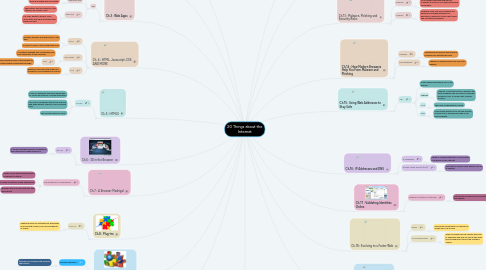
1. Ch.1 : What is the Internet?
1.1. TCP// IP
1.1.1. set of rules that allow communication between two computers
1.2. Bandwidth
1.2.1. Amount of data that can be sent in a second
1.3. Packets
1.3.1. data that gets split into chunks to efficiently send data to another computer
2. Ch.2 : Cloud Computing
2.1. Cloud Computing
2.1.1. A practice that uses the Internet to process, store, and edit files, documents, and music.
3. Ch.3 : Web Apps
3.1. App
3.1.1. Short for application. Has two different types of apps.
3.1.2. Traditional App
3.1.2.1. Designed to do broad tasks like word processing and accounting.
3.1.3. Web App
3.1.3.1. Applications that are running on the Internet, like Google Maps.
3.1.3.2. It is safer, easier to access, more up-to-date, and more accessible than traditional apps
4. Ch. 4 : HTML, Javascript, CSS AND MORE
4.1. HTML
4.1.1. Provides the basic building blocks of the web
4.1.2. Consists of lines of text, images and links.
4.2. Java Script
4.2.1. A scripting language that incorporates real time interaction to the computer
4.2.2. XHR
4.2.2.1. Allows individual parts of the program to be altered without refreshing the page.
4.3. CSS
4.3.1. Beautifies the page with design like animations, and a plethora of colours.
5. Ch.5 : HTML5
5.1. HTML5
5.1.1. A set of capabilities that allow developers to create the next set of online application
5.1.2. Has offline capabilities that let the user use web apps without Internet, such as Google Docs.
5.1.3. The current version of HTML.
6. Ch.6 : 3D in the Browser
6.1. 3D CSS
6.1.1. A technology that allows 3D modelling in web applications without plug-ins.
7. Ch.7 : A Browser Madrigal
7.1. The Negatives of Old Browsers
7.1.1. Higher risk of stolen passwords and vulnerable to attacks
7.1.2. Slows down innovation of web applications
7.1.3. Browsers may not work with new web applications
8. Ch.8 : Plug-ins
8.1. Plug-ins
8.1.1. Additional piece of software that specializes in processing content, such as flash games or videos
9. Ch.9 : Browser Extensions
9.1. Browser Extension`
9.1.1. Extends your browser with different applications
10. Ch.10 : Synchronizing the Browser
10.1. Sync (Browser)
10.1.1. Sync in Google Chrome allows you to sync your browser options to another computer.
11. Ch.11 : Browser Cookies
11.1. Cookie
11.1.1. A small piece of text that remembers the preferences you made on the web site, such as the preferred language.
12. Ch.12 : Browsers and Privacy
12.1. Browser Security
12.1.1. Prevents the user from malware, and online attacks
13. Ch.13 : Malware, Phishing and Security Risks
13.1. Phishing
13.1.1. An act where someone disguises as a website to trick you into sharing personal information.
13.2. Malware
13.2.1. Disguises as an anti-virus software and downloads software without your permission, leading to stolen credit cards and an infected computer.
14. Ch.14 : How Modern Browsers Help You From Malware and Phishing
14.1. Sandbox
14.1.1. Contained environment that prevents malware from entering the area.
14.2. Safe Browsing
14.2.1. Checks for malware every time you visit a website.
15. Ch.15 : Using Web Addresses to Stay Safe
15.1. URL
15.1.1. A web address that sends you to the website.
15.1.2. Scheme
15.1.2.1. Scheme, or Internet protocol specifies the type of website you are using. An example would be HTTP, or Hyper-Text-Transfer Protocol.
15.1.3. Host
15.1.3.1. The name of the website, usually.
15.1.4. Path
15.1.4.1. Some times referred to as the sub-domain, it sends you to the specific page of the host's website.
16. Ch.16 : IP Addresses and DNS
16.1. IP Addresses
16.1.1. Series of Numbers that tells us the location of a device on the Internet.
16.2. Domain Name Servers (DNS)
16.2.1. Translates a domain name address into an IP address.
17. Ch.17 : Validating Identities Online
17.1. Extended Validation Certificate
17.1.1. Determines the name and information of the website.
18. Ch.18 : Evolving to a Faster Web
18.1. WebP
18.1.1. New image format that can reduce file image file by up to 39%
18.2. DNS Preresolution
18.2.1. When a browser will pre-resolve links into IP addresses and look up links at the same time. Examples of this include Google's Search.
19. Ch.19 : Open Source and Browsers
19.1. Open Source
19.1.1. A source code that is made available to all, and is written in an open, more collaborative way.

